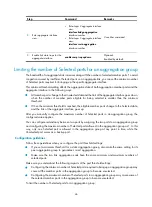
31
Configuring MAC Information
Overview
Introduction to MAC Information
To monitor a network, you must monitor users who are joining and leaving the network. Because a MAC
address uniquely identifies a network user, you can monitor users who are joining and leaving a network
by monitoring their MAC addresses.
With the MAC Information function, Layer 2 Ethernet ports send Syslog or trap messages to the monitor
end in the network when they obtain or delete MAC addresses. By analyzing these messages, the
monitor end can monitor users who are accessing the network.
How MAC Information works
When a new MAC address is obtained or an existing MAC address is deleted on a device, the device
writes related information about the MAC address to the buffer area used to store user information.
When the timer set for sending MAC address monitoring Syslog or trap messages expires, the device
sends the Syslog or trap messages to the monitor end.
The device writes information and sends messages only for the following MAC addresses: automatically
learned source MAC addresses, MAC addresses that pass MAC authentication, MAC addresses that
pass 802.1X authentication, MAC addresses matching OUI addresses in the voice VLAN feature, and
secure MAC addresses. The device does not write information or send messages for blackhole MAC
address, static MAC addresses, dynamic MAC addresses that are manually configured, multicast MAC
addresses, and local MAC addresses.
For more information about MAC authentication, 802.1X, and secure MAC addresses in port security,
see
Security Configuration Guide
. For more information about voice VLAN and OUI addresses, see
"Voice VLAN configuration."
Enabling MAC Information globally
Step Command
Remarks
1.
Enter system view.
system-view
N/A
2.
Enable MAC Information
globally.
mac-address information enable
Disabled by default.
Enabling MAC Information on an interface
To enable MAC Information on an Ethernet interface, enable MAC Information globally first.
To enable MAC Information on an interface:
















































